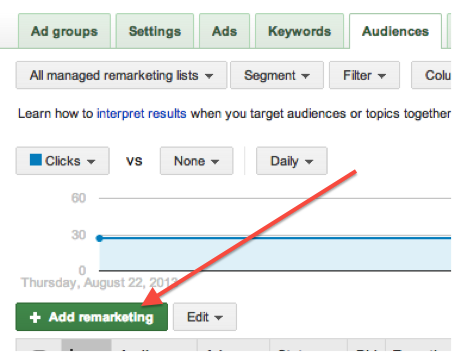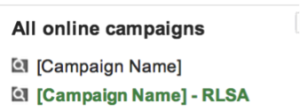Case Study: How Should You Be Using RLSAs?
If you were paying attention, you might recall that Google launched Remarketing Lists for Search Ads (RLSAs) at the end of June this year. Now that we’ve had a few months of experimenting with how to best make use of this feature, we’ve managed to come to some interesting preliminary conclusions. First, let’s revisit a couple […]
If you were paying attention, you might recall that Google launched Remarketing Lists for Search Ads (RLSAs) at the end of June this year. Now that we’ve had a few months of experimenting with how to best make use of this feature, we’ve managed to come to some interesting preliminary conclusions.
First, let’s revisit a couple of the basics:
What Are RLSAs?
RLSA campaigns use your remarketing lists to remarket to users on the Search Network. In layman’s terms, if someone has been to your website before, you can now use RLSA to set up a separate strategy for targeting them on Google.com and other sites in the company’s search network.
Why Are They Important?
RLSAs are potentially a game changer, and there is a reason that Google refers to it as “Remarketing 3.0” — it allows us to reap all the rewards we’ve had from regular remarketing on the extremely-focused and targeted search platform.
How Do You Implement Them?
Go into any Search Network campaign you have running, and open up the “Audiences” tab. From here, you should see the option to “Add remarketing.”

The AdWords Interface Section For Adding RLSA
You’ll need to assign your remarketing list to each ad group and to set a bid strategy. This bid strategy will be dependent on how you intend to structure RLSA campaigns within your account. You have two options: “Target and bid” or “Bid only.”
Target and bid means that your ads will only show when both your keywords and remarketing list are triggered (essentially an RLSA only campaign). Bid only, on the other hand, allows you to have a campaign continue to show ads to users not in any of your remarketing lists, while setting bid adjustments for those that are in your list.

Increasing a bid for RLSA by 25%
In the above example using Bid only, search queries will continue to trigger my ads at the existing bid, but users who have visited my website before will cause my ads to go into the auction with a 25% higher bid — hopefully showing the ad to that user at a higher avg. position and getting more of that high-value traffic.
Note: You currently can only use RLSAs through AdWords remarketing lists. There currently isn’t the functionality to make use of Analytics remarketing or YouTube remarketing lists — although you can use combinations as long as at least one of those lists is an AdWords one.
What Different Strategies Are Available?
There are 3 main ways in which you can make use of RLSAs. Google calls these the “3 levers.”
- Tailored Ad Text
- Optimized Bids
- Broaden Keywords
Tailored ad text is potentially huge. Our familiarity with a company or product plays an enormous role in how our brain reacts to it. Within conversion rate optimization circles, people are scrambling for ways to separate traffic into different buckets to market to. I recently bought an exercise bike and my own purchasing cycle looked something like this:
- Researching gym equipment for people who have slipped a disc in their back
- A recumbent exercise bike seems like a good idea!
- Which recumbent bike should I buy? Comparing models/prices/reviews
- Which company can get me that bike at the cheapest price
At each stage of that research, a Google ad/landing page combination would have had success using different approaches. At stage 1, a company would have been much more likely to make a sale by telling me about gym equipment great for people with bad backs and telling me stories about users who had helped improve their back problems. By stage 4, all I wanted to see was the product I knew I wanted, a good price and free shipping.
Take a look at this awareness scale (based on an awesome presentation from Brian Massey at Conversion Conference Chicago 2013) to get an idea for how you could alter your ad copy based upon awareness levels:

Graph charting different approaches to CRO based on awareness
A super-advanced RLSA set up might mean that you have multiple campaigns for each stage at which users left your site. When you take in all the possibilities from RLSA, it starts to feel like staring down the rabbit hole.
Optimized Bids
Alongside tailored ad copy, RLSAs give you options for bidding more optimally. Clearly, someone who has heard of your site should be valued differently from someone who has not. RLSAs allow us to take advantage of this. I prefer to double up my Campaigns as shown in the image below and then set bids based upon performance rather than use broad adjustments. Make sure to exclude your lists from your non-RLSA campaign if using this method.

An example of how RLSA might be set up
If you want to get a good idea for what your RLSA performance is naturally at (maybe for a month or so before optimizing bids), go ahead and add your remarketing lists to existing campaigns on bid only without having a bid adjuster — that way you’ll pull in stats without interfering with anything.
Generating Broader Reach
If you are looking to grow conversions rather than focus on CPA, trying out the broad reach approach to RLSA might be a good strategy.
Essentially, the premise is that you know a user is interested in your site, so why not try and serve them an ad when they are only searching for something semi-relevant. It’s as close to a search/display hybrid as there is. An example might be serving an ad based upon the Nike shoes they came to look at on your site earlier when they are just searching for any terms under broad match [clothes]. You know they are clothes shopping, so perhaps your Nike shoes ad is likely to tempt them back.
My recommendation at this stage is to keep these broad RLSA campaigns separate for budget reasons and to keep your bids low until you start to see success. A key to success with these campaigns will be having relevant ad copy that can play on both the broader keyword you are targeting and the user’s previous interest in your site.
“Nike shoes that compliment your new look. See all styles from $69.99!” might be an example that plays on the fact the user is now clothes shopping but previously had interest in your shoes.
What Have We Learned So Far?
Finally, we reach the crux of the article. All of these ideas work well in theory but not necessarily in practice. I pulled data from a mixture of our enterprise-level accounts that have been using RLSAs for a while now. Here is what we learned:
The most effective strategy for RLSAs is to focus on your “Top Keywords”
In accounts where our key goal was bid optimization — in other words, bidding up our top performing keywords to better positions for previous visitors -– we saw strong improvements in conversion numbers. Our most successful attempt at this saw really strong numbers:
What’s crazy is that this didn’t include any brand terms; those are just raw, great numbers.
The big question I had after seeing these numbers was: “Is this cannibalizing my existing traffic?” This is a pretty tough thing to check, as looking back over previous data leads to issues with changing market conditions, ad copy, competitor bidding etc. Anecdotally, I can say this account definitely saw an upward trend in conversions and improved CPAs. Google also maintains that their studies show incremental growth figures for accounts utilizing RLSA.
Overall, We Saw:
- Conversion Rate for RLSA campaigns better than average in 66% of accounts
- CPA better in 77% of accounts
- For accounts focusing on Return on Ad Spend, we saw a boost of 34%
- Total conversion rate across all accounts improved 5.88%
- CPA across all accounts got worse by 26.7%
So, despite the fact that in a majority of our accounts CPA was better, it was actually worse overall. This is due to the mix of strategies we were testing for RLSA. Accounts that focused on the “broad reach” approach generally had poor CPAs.
Summary
You can’t just expect RLSA to be a home run for you like display remarketing. However, you definitely should be expanding your RLSA efforts and working out how best to make use of it.
Opinions expressed in this article are those of the guest author and not necessarily Search Engine Land. Staff authors are listed here.
Related stories